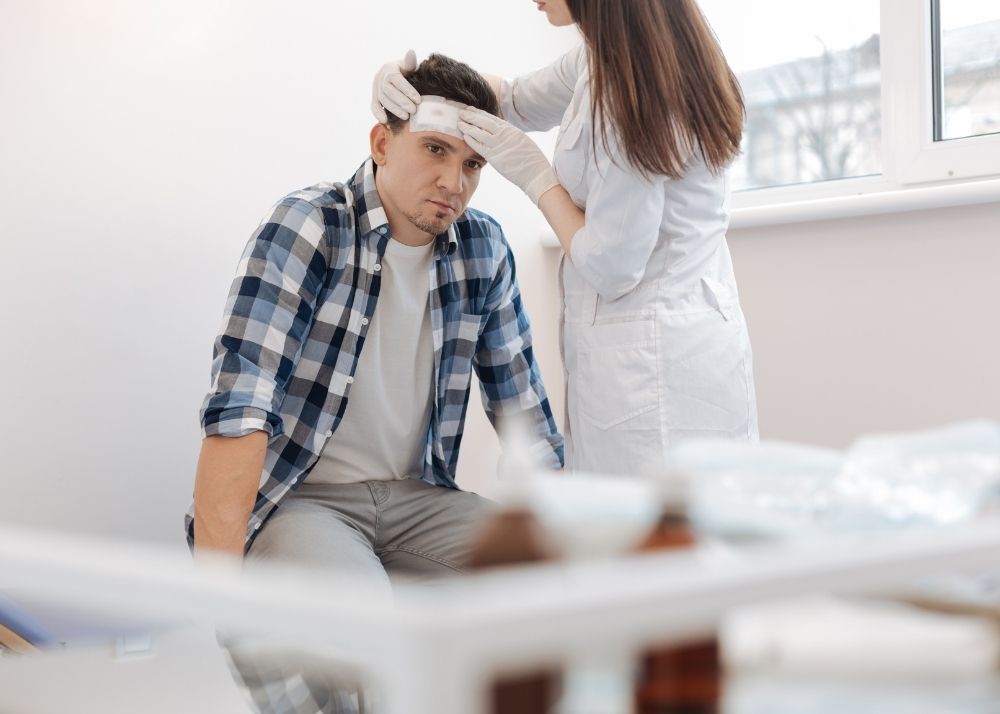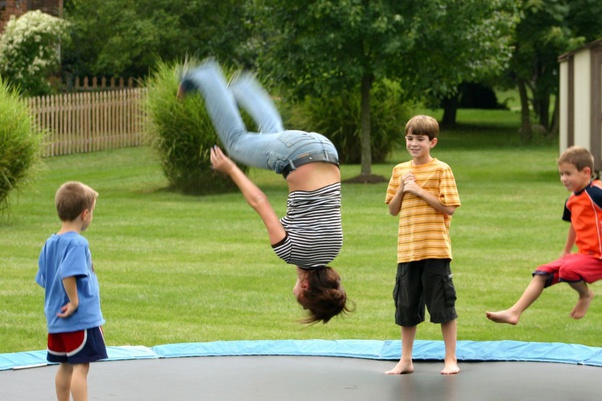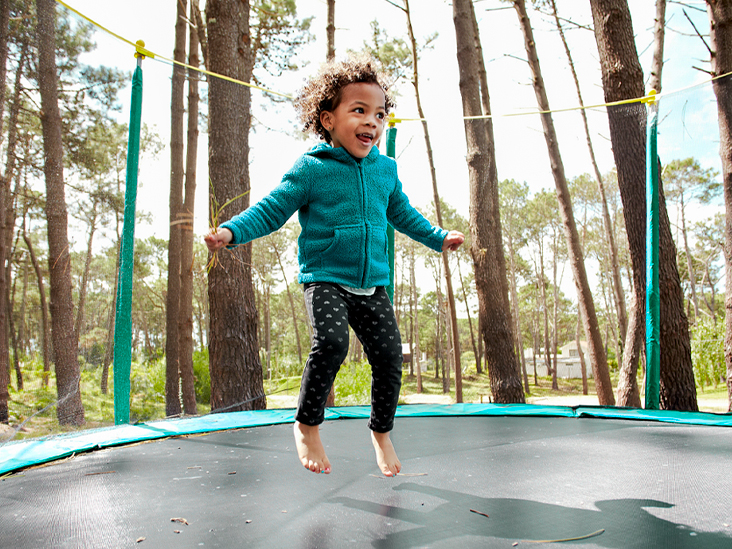If you’re anything like me, you’ve had a few jumps when you landed wrong and experienced a headache or neck ache. This may lead you to wonder if trampolining is harmful to your brain.
On the surface, the answer is no. Your brain will not be harmed by jumping on a trampoline. People’s brains are injured as they begin to do more strenuous exercises on the trampoline.
Why Do I Get a Headache When I Jump on the Trampoline?
Your brain and other inside organs will bounce up and down as you bounce on the trampoline. The meninges surround the brain, and the fluid in the meninges helps the brain move around in the skull (in this case, it is a disadvantage because of the bouncing on the trampoline). You may burst blood vessels, resulting in a hemorrhage, or you may injure brain tissue as the brain collides with the skull bones. On the trampoline, bouncing forcefully is a big risk. Reduce the amount of jumping you do and don’t do it on a regular basis.
Exercising, even on a trampoline, releases endorphins, increases blood flow to the brain, and relaxes muscles. There are additional factors that might be causing your headaches or migraines.
Neck Tension Is Too High
It’s possible that new trampolines will give you headaches. Tight muscles in the neck, chest, and/or shoulders cause headaches.
When some unfortunate persons begin to jump on a trampoline, they may experience greater pressure and stiffness in certain muscles, which diminishes when they stop.
If you’re one of the few people who get headaches when they jump on the trampoline, the solution is simple: you need to relax your neck muscles.
This can be achieved by doing some basic, light stretching activities like yoga, taking a warm shower or bath, administering heat or ice to the afflicted region, or receiving a massage to assist relieve the tension in that area.
Some people may require a combination of exercises to release tension in their neck, chest, or shoulders; everyone is different, so figure out what works best for you.
Unskilled Landings
The simple act of jumping on a trampoline can sometimes cause headaches. This usually indicates you’re not landing softly enough when you jump, leading your muscles to absorb the force rather than your joints.
Starting with less strenuous activities and gradually increasing to higher levels of activity is one approach. This might imply that your trampoline time will be restricted at first, and you won’t be able to do any spectacular feats.
However, as your body adjusts to the unique environment created by a trampoline and you learn to balance, land properly, and absorb impact, you will be able to increase the length of time spent on the trampoline and the intensity of your activity level.
Dehydration
You may be suffering from a headache as a result of dehydration. A headache produced by a lack of fluid in the body is known as a dehydration headache.
When you’re dehydrated, your brain may contract (little!) as a result of the fluid loss. As a result, the brain pulls away from the skull and generates discomfort in the form of a headache.
If you have drunk alcohol or taken medicines immediately before rebounding on a trampoline, you may get headaches.
Rehydrate
Your brain will return to its usual size once it has absorbed enough water, and you will feel relieved. This does not imply that you should drink a gallon of water before jumping on the trampoline.
Instead, make sure you drink enough water throughout the day on days when you’re jumping on the trampoline. Keep a water bottle with you at all times, and if you’re easily distracted, create reminders on your phone to remind you to drink enough water.
Sleep Deprivation
In some people, a lack of sleep can cause headaches, which is especially true when combined with other stressors (such as dehydration or exertion headaches, below).
According to research, lack of sleep lowers the body’s pain threshold, making us more susceptible to headaches.
In general, the best option is to try to address the factors that are stopping you from obtaining enough sleep and to strive for better sleep. On days when you haven’t gotten a decent night’s sleep, you may want to skip the trampoline in favor of an afternoon nap.
You can reschedule your trampoline workout for after your nap or on a day when you’ll get a better night’s sleep.
Exertion Headaches
Exertion headaches are a form of headache that occurs as a result of physical exertion. Although the sort and intensity of activity that causes a headache vary from person to person, it almost always involves some form of persistent, intense exertion.
An exertion headache can be treated in a number of ways. To begin, stretching and warm-up activities might help avoid exertion headaches. Exertion headaches arise when a person suddenly invests a great deal of effort or energy into physical activity.
To correct this, begin cautiously and gradually increase the intensity and length of your favorite exercise over the next few months. Exercising headaches can sometimes be caused by your surroundings and location.
For example, if you have exertion headaches when it’s very hot outside or when you’re at a higher altitude, it’s possible that these environmental variables are to blame.
Unfortunately, there are few options for dealing with this sort of issue. You should be able to avoid the geographical factors that cause a headache if possible. This, however, is not feasible for everyone. Warming up in an environment that causes a headache may be beneficial, with the degree of energy or exertion increasing week by week.
Medication, especially beta-blockers, can help with exercise headaches. According to several research, indomethacin is an effective medicine that may be used as needed, especially before a known trigger (such as exercise). It is, however, meant for short-term usage and would not be suggested for someone who suffers from exertion-induced headaches on a regular basis.
Can Trampoline Cause Migraines?
Fortunately, this question has a negative response. Migraines are not caused by trampolines. In fact, experts are baffled as to what causes these excruciating headaches or why they persist so long.
A shift in blood flow was considered to be one of the reasons for migraines by doctors. Trampolines may have been considered to cause headaches because they assist increase blood flow. Doctors have since revised their opinions and believe that migraines are caused by defects in the brain.
Doctors are certain that migraines are typically a hereditary feature, and that if one member of the family suffers from them, so will others in the same family.
What do You need to Know About Trampolines and Migraines?
Exertion headaches are headaches and migraines that occur after trampoline workouts and other forms of exercise. Because of the exertion they put themselves through when exercising on the trampoline, even children experience headaches after using it.
Children may vomit, have light sensitivity, and other symptoms after suffering from a headache. The good news is that trampoline headache usually not persist long, which is wonderful news for both adults and children. In one terrible stretch, you may be awake for up to 20 hours.
While trampolines may not be the cause of migraines, they can exacerbate them due to physical activity, fluid loss, and other factors. Trampolining can cause headaches. It isn’t something that happens after you’ve completed your workout.
How To Treat Headaches & Migraines After Trampoline Workouts
There are actions you may do to cure a headache or migraine that develops after you’ve completed your workout or while you’re on the trampoline. You don’t have to suffer in quiet with a stiff upper lip attitude.
Here are a few treatments that have been recommended:
- Over-the-counter medicine – you know, take a couple of aspirins or other non-prescription pain relievers.
- If you have a migraine, nausea medicine might help reduce some of the symptoms and discomfort.
- Other medications – often known as preventative medicine, these prescription tablets may include blood pressure medications, seizure medications, antidepressants, and other medications. Consult your doctor for further information and treatment options.
- Biofeedback – this may assist you in recognizing the stress in your current circumstances and providing you with actions to follow to prevent the migraine from becoming severe.
How To Avoid Headache After Trampoline?
While the majority of these avoidance strategies are geared for youngsters, adults should be able to use them as well. Adults and children can both get trampoline headaches from the same conditions.
- Keep an eye on where you workout because hot weather and high altitudes might cause headaches. Of course, some people are unable to escape these geographical circumstances.
- Drink lots of fluids when exercising – water or excellent, nutritious sports drinks should suffice.
- Warming up is important because you must stretch and relax your muscles, and a proper warm-up workout or period can help you avoid headaches.
- Reduce your impact workouts – that is, eliminate jogging motions that jolt your body and mind. Opt for low-impact workouts.
- Yoga may be beneficial – the various postures and movements should assist to keep migraines and headaches at bay.
- Take medicine – not after your workout, when the headache has already set in, but around 2 to 3 hours before your workout, with some kind of nonsteroidal anti-inflammatory drug.
- Get plenty of rest – this generally happens after the headache or migraine has struck, but getting plenty of rest can help you relax and relieve tension.
What Are The Benefits Of Trampoline?
The brain-body link is also a hot topic in science right now. Did you know that any type of exercise causes nerve cells to generate molecules called neurotrophic factors, which function as brain fertilizer? These are proteins that enable brain cells to interact with other neutrons and drive new brain cell development.
Even better, the “against gravity” up and down action of bouncing on a trampoline distributes oxygen to all tissues, resulting in stronger neural connections between the left and right brain. Furthermore, when bouncing, the lymphatic ducts stretch, allowing lymph flow to rise by up to fourteen times normal. This procedure aids in the development of a stronger immune system as well as the detoxification of the body.
Visual coordination is improved by jumping on the trampoline with your eyes fixated on a fixed place. As a result, brain coordination for sports and daily tasks improves. The capacity to move in all directions while moving the body up and down assists to generate greater brain function. According to Alfhild Akselsen, Ph.D., of Austin, Texas, “when you are rebounding, you are moving and working every brain cell just as you are training each of the other bodily cells.” Dr. Akselsen utilizes rebounding therapy to help people with neurological problems.
I didn’t realize any of these advantages when I was a teenager; I simply trampolined because it was fun! I’m pleased I was able to make use of all of these advantages, and I hope you will be able to as well!
Conclusion
It is critical that you do not discard your trampoline simply because you have headaches or migraines after using it. These painful disorders are not caused by trampolines.
Look for other sources and review your training regimen to determine whether you’re getting enough water, warming up properly, or if your blood sugar levels are off.
The good news is that not everyone will have headaches or migraines after using or finishing their trampoline. If you’re one of the lucky ones who doesn’t, thank you. It’s not fun to put up with them.
Migraines are a genetic condition. It’s possible that one of your parents or grandparents has had them. Once you know the source, you can take the necessary precautions to avoid them and continue to use your trampoline. Headaches and migraines should not be used as an excuse to quit exercising.


